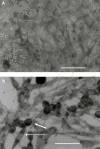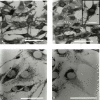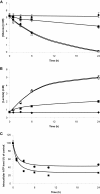Microglia in close vicinity of glioma cells: correlation between phenotype and metabolic alterations
- PMID: 21031160
- PMCID: PMC2965014
- DOI: 10.3389/fnene.2010.00131
Microglia in close vicinity of glioma cells: correlation between phenotype and metabolic alterations
Abstract
Microglia are immune cells within the central nervous system. In brain-developing tumors, gliomas are able to silence the defense and immune functions of microglia, a phenomenon which strongly contributes to tumor progression and treatment resistance. Being activated and highly motile, microglia infiltrate tumors and secrete macrophagic chemoattractant factors. Thereafter, the tumor cells shut down their immune properties and stimulate the microglia to release tumor growth-promoting factors. The result of such modulation is that a kind of symbiosis occurs between microglia and tumor cells, in favor of tumor growth. However, little is known about microglial phenotype and metabolic modifications in a tumoral environment. Co-cultures were performed using CHME5 microglia cells grown on collagen beads or on coverslips and placed on monolayer of C6 cells, limiting cell/cell contacts. Phagocytic behavior and expression of macrophagic and cytoskeleton markers were monitored. Respiratory properties and energetic metabolism were also studied with regard to the activated phenotype of microglia. In co-cultures, transitory modifications of microglial morphology and metabolism were observed linked to a concomitant transitory increase of phagocytic properties. Therefore, after 1 h of co-culture, microglia were activated but when longer in contact with tumor cells, phagocytic properties appear silenced. Like the behavior of the phenotype, microglial respiration showed a transitory readjustment although the mitochondria maintained their perinuclear relocation. Nevertheless, the energetic metabolism of the microglia was altered, suggesting a new energetic steady state. The results clearly indicate that like the depressed immune properties, the macrophagic and metabolic status of the microglia is quickly driven by the glioma environment, despite short initial phagocytic activation. Such findings question the possible contribution of diffusible tumor factors to the microglial metabolism.
Keywords: C6 cells; NMR spectroscopy; glioma; metabolism; microglia; phenotype.
Figures









Similar articles
-
C6 glioma cell insoluble matrix components enhance interferon-gamma-stimulated inducible nitric-oxide synthase/nitric oxide production in BV2 microglial cells.J Biol Chem. 2008 Feb 1;283(5):2526-33. doi: 10.1074/jbc.M610219200. Epub 2007 Nov 2. J Biol Chem. 2008. PMID: 17981810
-
Molecular definition of the pro-tumorigenic phenotype of glioma-activated microglia.Glia. 2013 Jul;61(7):1178-90. doi: 10.1002/glia.22510. Epub 2013 May 7. Glia. 2013. PMID: 23650109
-
Wasl is crucial to maintain microglial core activities during glioblastoma initiation stages.Glia. 2022 Jun;70(6):1027-1051. doi: 10.1002/glia.24154. Epub 2022 Feb 22. Glia. 2022. PMID: 35194846 Free PMC article.
-
Roles of purinergic P2X7 receptor in glioma and microglia in brain tumors.Cancer Lett. 2017 Aug 28;402:93-99. doi: 10.1016/j.canlet.2017.05.004. Epub 2017 May 20. Cancer Lett. 2017. PMID: 28536012 Review.
-
Microglia: intrinsic immuneffector cell of the brain.Brain Res Brain Res Rev. 1995 Mar;20(3):269-87. doi: 10.1016/0165-0173(94)00015-h. Brain Res Brain Res Rev. 1995. PMID: 7550361 Review.
Cited by
-
Immunosuppression in Gliomas via PD-1/PD-L1 Axis and Adenosine Pathway.Front Oncol. 2021 Feb 15;10:617385. doi: 10.3389/fonc.2020.617385. eCollection 2020. Front Oncol. 2021. PMID: 33659213 Free PMC article. Review.
-
The Glioblastoma Microenvironment: Morphology, Metabolism, and Molecular Signature of Glial Dynamics to Discover Metabolic Rewiring Sequence.Int J Mol Sci. 2021 Mar 24;22(7):3301. doi: 10.3390/ijms22073301. Int J Mol Sci. 2021. PMID: 33804873 Free PMC article. Review.
-
The Role of Myeloid Cells in GBM Immunosuppression.Front Immunol. 2022 May 31;13:887781. doi: 10.3389/fimmu.2022.887781. eCollection 2022. Front Immunol. 2022. PMID: 35711434 Free PMC article. Review.
-
Glioma-induced inhibition of caspase-3 in microglia promotes a tumor-supportive phenotype.Nat Immunol. 2016 Nov;17(11):1282-1290. doi: 10.1038/ni.3545. Epub 2016 Sep 12. Nat Immunol. 2016. PMID: 27618552
-
Proinflammatory-activated glioma cells induce a switch in microglial polarization and activation status, from a predominant M2b phenotype to a mixture of M1 and M2a/B polarized cells.ASN Neuro. 2014 May 8;6(3):171-83. doi: 10.1042/AN20130045. ASN Neuro. 2014. PMID: 24689533 Free PMC article.
References
-
- Aloisi F. (2001). Immune function of microglia. Glia 36, 165–179 - PubMed
-
- Asai J., Suzuki R., Fujimoto T., Suzuki T., Nakagawa N., Nagashima G., Miyo T., Hokaku H., Takei A. (1999). Fluorescence automatic cell sorter and immunohistochemical investigation of CD68-positive cells in meningioma. Clin. Neurol. Neurosurg. 101, 229–23410.1016/S0303-8467(99)00052-9 - DOI - PubMed
LinkOut - more resources
Full Text Sources

